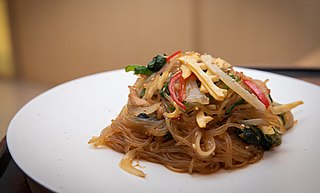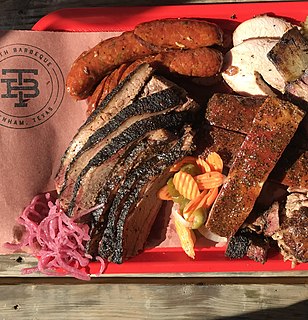


Shredded beef is a preparation of beef that features in dishes from various cuisines. Shredded beef is sometimes prepared using beef brisket [1] and chuck roast. [2] [3] Pot roast is also sometimes shredded. [4]



Shredded beef is a preparation of beef that features in dishes from various cuisines. Shredded beef is sometimes prepared using beef brisket [1] and chuck roast. [2] [3] Pot roast is also sometimes shredded. [4]

Puerto Rican cuisine has its roots in the cooking traditions and practices of Europe, Africa and the native Taínos. Since the latter part of the 19th century, Puerto Rican cuisine can be found in several other countries.

Bulgogi, literally "fire meat", is a gui made of thin, marinated slices of beef or pork grilled on a barbecue or on a stove-top griddle. It is also often stir-fried in a pan in home cooking. Sirloin, rib eye or brisket are frequently used cuts of beef for the dish. The dish originated from northern areas of the Korean Peninsula, but is a very popular dish in South Korea, where it can be found anywhere from upscale restaurants to local supermarkets as pan-ready kits.

Fried rice is a dish of cooked rice that has been stir-fried in a wok or a frying pan and is usually mixed with other ingredients such as eggs, vegetables, seafood, or meat. It is often eaten by itself or as an accompaniment to another dish. Fried rice is a popular component of East Asian, Southeast Asian and certain South Asian cuisines, as well as a staple national dish of Indonesia. As a homemade dish, fried rice is typically made with ingredients left over from other dishes, leading to countless variations. Fried rice first developed during the Sui Dynasty in China and as such all fried rice dishes can trace their origins to Chinese fried rice.

Korean royal court cuisine was the style of cookery within Korean cuisine traditionally consumed at the court of the Joseon Dynasty, which ruled Korea from 1392 to 1910. There has been a revival of this cookery style in the 21st century. It is said that twelve dishes should be served along with rice and soup, with most dishes served in bangjja (bronzeware).

New Mexican cuisine is the cuisine of the Southwestern US state of New Mexico, the region is primarily known for its fusion of Pueblo Native American cuisine with Hispano Spanish and Mexican cuisine originating in Nuevo México.

Japchae is a savory and slightly sweet dish of stir-fried glass noodles and vegetables that is popular in Korean cuisine. Japchae is typically prepared with dangmyeon, a type of cellophane noodles made from sweet potato starch; the noodles are mixed with assorted vegetables, meat, mushrooms, and seasoned with soy sauce and sesame oil.

Rice and beans is a category of dishes from many cultures around the world, whereby the staple foods of rice and beans are combined in some manner. The grain and legume combination provides several important nutrients and many calories, and both foods are widely available. Rice and beans are vegan and, when combined, make up a complete protein. The beans are usually seasoned, while the rice may be plain or seasoned. The two components may be mixed together, separated on the plate, or served separately.

Picadillo is a traditional dish in many Latin American countries and the Philippines. It is made with ground meat, tomatoes, and also raisins, olives, and other ingredients that vary by region. It is often served with rice or used as a filling in dishes such as tacos, savory pastries or croquettes. The name comes from the Spanish word picar, meaning "to mince".

Banchan or bansang is a collective name for small side dishes served along with cooked rice in Korean cuisine. As the Korean language does not distinguish between singular and plural grammatically, the word is used for both one such dish or all of them combined.

Tangpyeong-chae or mung bean jelly salad is a Korean dish that was part of the Korean royal court cuisine. It is made by mixing julienned nokdumuk, mung bean sprouts, watercress, stir-fried shredded beef, thinly shredded red pepper and lightly broiled gim. Tangpyeongchae is seasoned with a sauce made with ganjang, vinegar, sugar, sesame seeds and sesame oil. The dish is most often eaten in late spring and summer.

Most traditional foods in Guatemalan cuisine are based on Maya cuisine, with Spanish influence, and prominently feature corn, chilies and beans as key ingredients. Guatemala is famously home to the Hass avocado and the birthplace of chocolate, as first created by the Maya.

Korean barbecue refers to the popular method in Korean cuisine of grilling meat, typically beef, pork or chicken. Such dishes are often prepared on gas or charcoal grills built into the dining table itself. Some Korean restaurants that do not have built-in grills provide customers with portable stoves for diners to use at their tables. Alternatively, a chef uses a centrally displayed grill to prepare dishes to order.

Yukgaejang or spicy beef soup is a spicy, soup-like Korean dish made from shredded beef with scallions and other ingredients, which are simmered together for a long time. It is a variety of gomguk, or thick soup, which was formerly served in Korean royal court cuisine. It is thought to be healthful and is popular due to its hot and spicy nature.

Texan cuisine is the food associated with the Southern U.S. state of Texas, including its native Southwestern cuisine influenced Tex-Mex foods. Texas is a large state, and its cuisine has been influenced by a wide range of cultures, including Southern, German, Czech, British, African American, Creole/Cajun, Mexican, New Mexican, Native American, Asian, Jewish, and Italian.

Breaded cutlet is a dish made from coating a cutlet of meat with breading or batter and either frying or baking it. Breaded cutlet is known as schnitzel in German-speaking countries, cotoletta alla milanese in Italy, escalope in France, filete empanado in Spain, filete empanizado in Cuba, milanesa in Latin America, katsu in Japan and Korea, kotlet in Poland, řízek in Czech Republic and kotleta in post-Soviet countries.

The Eurasian cuisine is a 'fusion' cuisine, mainly existing still in Singapore and Malaysia.